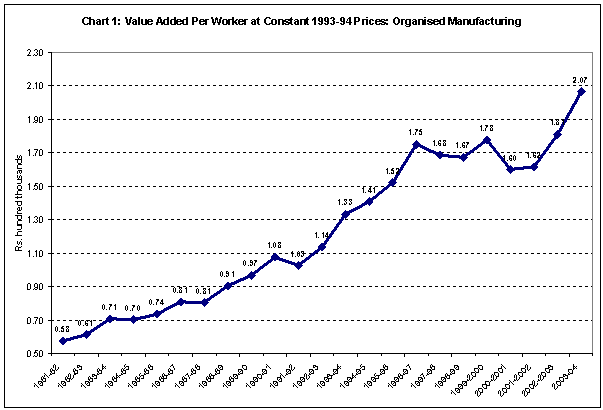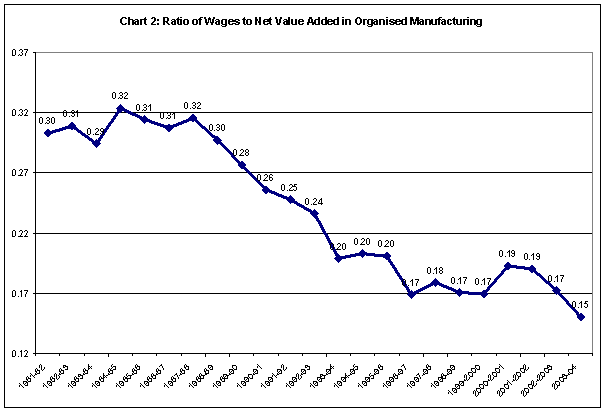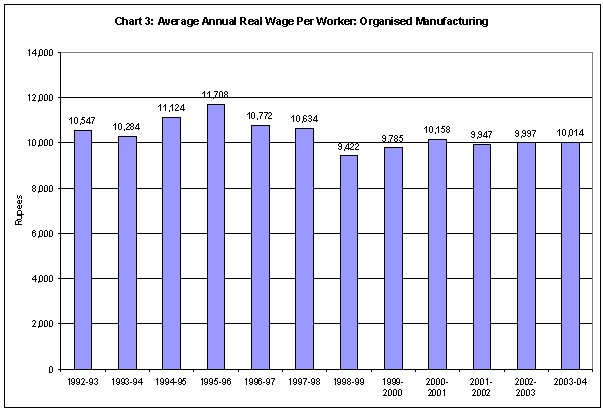 People's Democracy
People's Democracy
(Weekly
Organ of the Communist Party of India (Marxist)
No. 17
April 29, 2007
(Weekly
Organ of the Communist Party of India (Marxist)
|
Vol.
XXXI
No. 17 April 29, 2007 |
Growth And Employment In Organised Industry
C P Chandrasekhar
THERE is a general perception of industrial dynamism in the Indian economy at present, fed by reasonably high, even if not remarkable, rates of industrial growth especially since the mid 1990s. While the average rate of growth of manufacturing production in the decade up to 2004-05 has been 5.83 per cent per year, the most rapid growth has been experienced in the consumer durable sector, which has registered annual rates of growth of more than 9 per cent.
What is seldom noted is that this output growth, while marginally better than that recorded over the 1980s, has also exhibited an increase in volatility. The average annual growth of manufacturing production over the period 1994-95 to 2004-05 (at 6.4 per cent) was slightly higher than that of the period 1980-81 to 1990-91 (6.2 per cent). However, in the 1980s, all years (excepting two) were characterised by rates of growth near or above the average rate. But in the subsequent period after 1994-95, annual rates at or above the average were far less frequent. Value added figures from the ASI point to an even greater degree of volatility.
GREATER INSTABILITY
Several factors explain the greater instability. First, public expenditure has been more unstable in the past decade. This is partly because of variations in the government’s degree of adherence to its irrational fiscal deficit targets, partly because of a sudden burgeoning of public expenditure towards the end of the 1990s because of the implementation of the Fifth Pay Commission’s recommendations and partly because of the influence of the political business cycle.
A second factor in increased volatility of manufacturing production was trade liberalisation. This led to a sudden increase in access to domestically assembled or produced import-intensive manufactured goods, and promoted such production. But it also adversely affected other domestic production through greater import competition.
Finally, instability resulted from the specific way in which the market for manufactures has been expanded, especially in urban India, during the years of neo-liberal reform: through a boom in housing and consumer credit. One consequence of financial liberalisation and the excess liquidity in the system created by the inflow of foreign capital, has been the growing importance of credit provided to individuals for specific purposes such as purchases of property, consumer durables and automobiles of various kinds.
This implies a degree of dissaving on the part of individuals and households. It also implies that financial institutions, which are willing to provide such credit without any collateral, are betting on the inter-temporal income profile of these individuals, since they are seen as being in a position to meet their interest payment and amortisation commitments based on speculative projections of their earnings profile. These projections are speculative because with banks and other financial institutions competing with each other in the housing and consumer finance markets, individuals can easily take on excess debt from multiple sources, without revealing to any individual creditor their possible over-exposure to debt.
One implication of the expansion of the market for manufactures through these means is that the occurrence and the extent of such an expansion depend crucially on the “confidence” of both lenders and borrowers. Since there is a strong speculative element involved in lenders providing credit and borrowers increasing their indebtedness, the state of confidence of both parties matters. When such confidence is “good” we can experience growth or even a mini-boom. When such confidence is low in the case of either borrowers or lenders, we can experience recessionary conditions. This makes a degree of volatility in the demand for manufactures inevitable.
An important implication of debt-financed manufacturing demand is that it tends to be concentrated in a narrow range of commodities that are the targets of personal finance, such as construction materials, automobiles and consumer durables. To the extent that such production is capital- and import-intensive in nature, the domestic employment and linkage effects of this expansion would be limited, and manufacturing growth would become increasingly dependent on speculative factors.
DISCONCERTING FEATURE
These features of recent industrial growth may help to explain one of the most disconcerting features of industrial development during the 1990s: the apparently negative relation between output and employment growth in organised industry. While it is known that the manufacturing sector tends to be far less labour absorbing than agriculture or services, this feature of growth in organised industry is extremely disturbing and clearly requires policy intervention for correction.
Official figures indicate that aggregate employment in the organised manufacturing sector has fallen in absolute terms since 1997. Public organised employment, having risen from 155 lakh persons in 1981 to a peak of 196 lakh persons in 1996, had fallen to 186 lakh persons by 2003. Private organised employment, which stagnated during the 1980s, grew between 1993 and 1997, but thereafter has also fallen marginally and stood at 87 lakh persons in 2003.
There are reasons to believe that the pattern of manufacturing growth under an open economic regime tends to be such that the responsiveness of employment growth to the growth in output declines. It is worth noting that the combination of high output growth and low employment growth, is a feature that has characterised both India and China during the years when they have opened their economies to trade and investment. There are several reasons for this:
(i) As tastes and preferences of the elites in developing countries are influenced by the “demonstration effect” of lifestyles in the developed countries, new products and processes introduced in the latter very quickly find their way to the developing countries when their economies are open.
(ii) Technological progress in the form of new products and processes in the developed countries is inevitably associated with an increase in labour productivity. Producers in developing countries find that the pressure of external competition (in both exporting and import-competing sectors) requires them to adopt such technologies.
Hence, after external trade has been liberalised, labour productivity growth in developing countries is more or less exogenously given and tends to be higher than that prior to trade liberalisation. This is the primary cause of the growing divergence between output and employment growth.
These expectations are corroborated by evidence relating to India’s factory sector. One striking feature of the organised manufacturing sector during the years of liberalisation has been a sharp and persistent increase in labour productivity as measured by the net value added (at constant prices) generated per worker.
As Chart 1 based on data from the Annual Survey of Industries shows, labour productivity tripled between 1981-82 and 1996-97, stagnated and even slightly declined during the years of the industrial slowdown that set in thereafter, and has once again been rising sharply in the early years of this decade.

However, the benefits of this labour productivity increase went largely to those deriving rent, interest and profit incomes, rather than workers. This is clear from Chart 2, which shows that the share of wages in value added, which was stable through much of the 1980s, has been declining almost consistently since the late 1980s till 1996-97 and then after a period of stability fell sharply to less than half of its level in the mid 1990s. This was the result of two developments: the fall in the number of workers and the decrease/stagnation in real wages of those workers, even as the value of output kept increasing.

SHARP DECLINE IN EMPLOYMENT & WAGES
As noted earlier, restructuring of the public sector has meant that public sector manufacturing employment which was rising during the 1980s, was on the decline during the years of liberalisation and fell particularly sharply after 1997. Private organised manufacturing employment which was stagnant during the 1980s, rose marginally during the early 1990s and particularly sharply during 1995-97, after which it has declined to return to its mid-1990s level by 2003. In the event, aggregate (public and private) organised manufacturing employment rose from 6.1 million in 1981 to 6.4 million in 1994 and 6.9 million in 1997, and then declined sharply to 6 million in 2003.
Meanwhile, contrary to public perception, the average real wage of workers in the organised manufacturing sector has been more or less constant right through the 1990s. As Chart 3 shows, average real wages increased in the early years of the 1990s, until 1996-96, and then fell quite sharply. The subsequent recovery after 1998 has been muted, and real wages have stagnated since 2000. As a result, real wages in the triennium ending 2003-04 were around 11 per cent lower than real wages in the triennium ending 1995-96.
This is despite the rapid growth in industry, and contributes to an explanation of the explosion in corporate profits in the very recent period. There could not be stronger confirmation of the dramatically reduced bargaining power of workers in organised industry over the past decade.
Together, these have ensured that the benefits of the rise in labour productivity have largely gone to the surplus earners in the sector, who have been the main beneficiaries in the organised manufacturing sectors of the policies of liberalisation in general and trade liberalisation in particular.
What is particularly striking is that even falling real wages in a context of relatively strong growth in organised industry and rising labour productivity have not been sufficient to ensure growth in employment. The negative effects of openness on employment generation have been strong enough to offset any supposed “benefits” of labour becoming cheaper in real terms for employers.

This new trend therefore suggests that greater employment generation is not a necessary result of more growth in organised industry – indeed, it could even be associated with falling employment in future as well. This is an extremely important fact that policy makers must take on board, if there is to be even a pretence of “more inclusive” economic growth in the country.